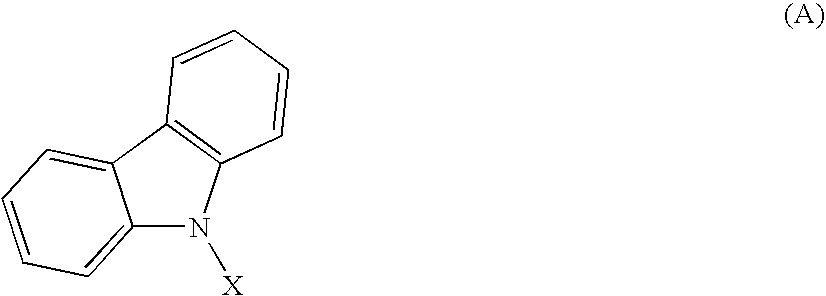Material for organic electroluminescent element and organic electroluminescent element employing the same
- Summary
- Abstract
- Description
- Claims
- Application Information
AI Technical Summary
Benefits of technology
Problems solved by technology
Method used
Image
Examples
synthesis example 1
Synthesis of Compound (A1)
[0067] The route of synthesis of Compound (A1) is shown in the following.
[0068] Into a reactor, 3.92 g (10 mmole) of 1,l-bis(p-bromophenyl)-cyclohexane, 4.0 g (24 mmole) of carbazole, 0.6 g of copper powder, 1.7 g of 18-crown-6 and 2.9 g (21 mmole) of potassium carbonate were placed. After 50 milliliter of o-dichlorobenzene as the solvent was added, the resultant mixture was heated at 200° C. in a silicone oil bath under a stream of nitrogen, and the reaction was allowed to proceed for 48 hours. After the reaction was completed, the reaction mixture was filtered before the mixture was cooled, and the obtained filtrate was concentrated using a rotary evaporator. To the obtained oily product, 30 milliliter of methanol was added. The formed solid substance was separated by filtration under a reduced pressure, and a gray solid substance was obtained. The obtained solid substance was recrystallized from benzene, and 2.6 g (4.6 mmole) (the yield: 46%) of white...
synthesis example 2
Synthesis of Compound (A4)
[0071] The route of synthesis of Compound (A4) is shown in the following.
[0072] The reaction was conducted under the same conditions as those in Synthesis Example 1 except that 1,3-dibromoadamantane was used in place of 1,1-bis(p-bromophenyl)cyclohexane and 3,6-diphenylcarbazole was used in place of carbazole. The obtained solid substance was recrystallized from toluene, and 1.9 g (the yield: 25%) of white crystals were obtained. It was confirmed in accordance with 90 MHz 1H-NMR and FD-MS that the obtained crystals were Compound (A4) of the object compound. The result of the measurement by FD-MS is shown in the following.
[0073] FD-MS calcd. for C58H48N2=770; found: m / z=770 (M+, 100)
[0074] The singlet energy gap and the triplet energy gap of the obtained compound are shown in Table 1.
synthesis example 3
Synthesis of Compound (B1)
[0075] The route of synthesis of Compound (B1) is shown in the following.
[0076] 3,6-Dibromo-N-phenylcarbazole in an amount of 4 g (10 mmole) was dissolved into 50 milliliter of dehydrated tetrahydrofuran (THF). To the resultant solution, a solution obtained by dissolving 5.8 g (24 mmole) of 1-adamantylmagnesium bromide into 20 milliliter of THF was added dropwise. The obtained mixture was stirred under the refluxing condition under a stream of nitrogen for 12 hours, and the reaction was allowed to proceed for 12 hours. After the reaction was completed, 6N hydrochloric acid was added to the reaction mixture, and the obtained mixture was stirred. The formed organic layer was separated, washed with water and dried with anhydrous magnesium chloride. The solvent was removed by distillation from the obtained extract using a rotary evaporator, and a brown solid substance was obtained. The obtained solid substance was recrystallized from benzene, and 1.1 g (the ...
PUM
| Property | Measurement | Unit |
|---|---|---|
| Energy gap | aaaaa | aaaaa |
| Energy gap | aaaaa | aaaaa |
| Area | aaaaa | aaaaa |
Abstract
Description
Claims
Application Information
 Login to View More
Login to View More - R&D
- Intellectual Property
- Life Sciences
- Materials
- Tech Scout
- Unparalleled Data Quality
- Higher Quality Content
- 60% Fewer Hallucinations
Browse by: Latest US Patents, China's latest patents, Technical Efficacy Thesaurus, Application Domain, Technology Topic, Popular Technical Reports.
© 2025 PatSnap. All rights reserved.Legal|Privacy policy|Modern Slavery Act Transparency Statement|Sitemap|About US| Contact US: help@patsnap.com



